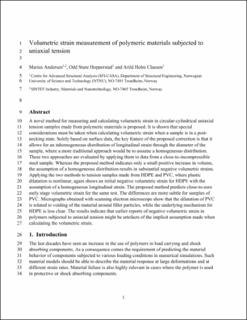| dc.contributor.author | Andersen, Marius Endre | |
| dc.contributor.author | Hopperstad, Odd Sture | |
| dc.contributor.author | Clausen, Arild Holm | |
| dc.date.accessioned | 2020-11-24T13:45:03Z | |
| dc.date.available | 2020-11-24T13:45:03Z | |
| dc.date.created | 2019-07-08T17:48:56Z | |
| dc.date.issued | 2019 | |
| dc.identifier.citation | Strain. 2019, 55 (4), . | en_US |
| dc.identifier.issn | 0039-2103 | |
| dc.identifier.uri | https://hdl.handle.net/11250/2689374 | |
| dc.description.abstract | A novel method for measuring and calculating volumetric strain in circular cylindrical uniaxial tension samples made from polymeric materials is proposed. It is shown that special considerations must be taken when calculating volumetric strain when a sample is in a postnecking state. Solely based on surface data, the key feature of the proposed correction is that it allows for an inhomogeneous distribution of longitudinal strain through the diameter of the sample, where a more traditional approach would be to assume a homogeneous distribution. These two approaches are evaluated by applying them to data from a close‐to‐incompressible steel sample. Whereas the proposed method indicates only a small positive increase in volume, the assumption of a homogeneous distribution results in substantial negative volumetric strains. Applying the two methods to tension samples made from HDPE and PVC, where plastic dilatation is nonlinear, again shows an initial negative volumetric strain for HDPE with the assumption of a homogeneous longitudinal strain. The proposed method predicts close‐to‐zero early‐stage volumetric strain for the same test. The differences are more subtle for samples of PVC. Micrographs obtained with scanning electron microscope show that the dilatation of PVC is related to voiding of the material around filler particles, while the underlying mechanism for HDPE is less clear. The results indicate that earlier reports of negative volumetric strain in polymers subjected to uniaxial tension might be artefacts of the implicit assumption made when calculating the volumetric strain. | en_US |
| dc.language.iso | eng | en_US |
| dc.publisher | Wiley | en_US |
| dc.subject | volumetric strain | en_US |
| dc.subject | volumetric correction | en_US |
| dc.subject | uniaxial tension | en_US |
| dc.subject | PVC | en_US |
| dc.subject | polymers | en_US |
| dc.subject | plastic dilatation | en_US |
| dc.subject | parabolic method | en_US |
| dc.subject | material testing | en_US |
| dc.subject | HDPE | en_US |
| dc.subject | DIC | en_US |
| dc.title | Volumetric strain measurement of polymeric materials subjected to uniaxial tension | en_US |
| dc.type | Peer reviewed | en_US |
| dc.type | Journal article | en_US |
| dc.description.version | acceptedVersion | en_US |
| dc.rights.holder | This is the peer reviewed version of an article, which has been published in final form at [https://doi.org/10.1111/str.12314]. This article may be used for non-commercial purposes in accordance with Wiley Terms and Conditions for Self-Archiving. | en_US |
| dc.source.pagenumber | 13 | en_US |
| dc.source.volume | 55 | en_US |
| dc.source.journal | Strain | en_US |
| dc.source.issue | 4 | en_US |
| dc.identifier.doi | 10.1111/str.12314 | |
| dc.identifier.cristin | 1710702 | |
| dc.relation.project | Norges forskningsråd: 237885 | en_US |
| cristin.unitcode | 7401,80,64,0 | |
| cristin.unitname | Materialer og nanoteknologi | |
| cristin.ispublished | true | |
| cristin.fulltext | postprint | |
| cristin.qualitycode | 1 | |
